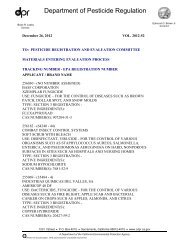Dichlorvos (DDVP) Risk Characterization Document - California ...
Dichlorvos (DDVP) Risk Characterization Document - California ...
Dichlorvos (DDVP) Risk Characterization Document - California ...
You also want an ePaper? Increase the reach of your titles
YUMPU automatically turns print PDFs into web optimized ePapers that Google loves.
TABLE 2: Percent <strong>DDVP</strong> Dermal Absorption in Rats.<br />
================================================================================<br />
Applied Dose<br />
Observation Period (hours)<br />
(ug/cm 2 ) 10 24 120<br />
30.0 13.3 11.4 12.9<br />
3.0 10.7 11.0 12.7<br />
0.3 7.3 10.8 9.8<br />
================================================================================<br />
Formoli, WH&S, 1992<br />
METABOLIC DISPOSITION<br />
<strong>DDVP</strong> is rapidly metabolized by mammals (Hudson, 1971). There is very little parent material found in tissues or<br />
biological media after exposure to <strong>DDVP</strong>. The metabolic products include dimethyl phosphate (DMP), dichloroacetic<br />
acid, dichloro-ethanol glucuronide and carbon dioxide (Hudson, 1972). After oral or intraperitoneal<br />
administration of 14 C (vinyl)-<strong>DDVP</strong>, most of the radiolabel, 27 to 32 percent, was found in the urine, 16 percent in<br />
the expired CO 2 and 3 percent in the feces (24 hours post-application) (Shell, 1970).<br />
An early multiphasic study of different carriers and radiolabels (Casida, 1962) used <strong>DDVP</strong> labeled at either the<br />
alpha-dichlorovinyl carbon ( 14 C) or the phosphorous ( 32 P). Rats were orally dosed with the test material in either<br />
water, corn oil, or propylene glycol at rates of 10 or 4 mg/kg. The data is reported in parts-per-million and is not<br />
convertible to ug or percentage. The results indicate that the 32 P label is retained in the bone, probably as<br />
incorporated phosphate. The 14 C label appears, even after 7 days, in the liver. But the radioactive residue was not<br />
<strong>DDVP</strong> and was most likely 14 C that was removed from <strong>DDVP</strong>, metabolized into the carbon-pool and utilized by the<br />
body for other functions.<br />
DMP is an excellent indicator of total dermally absorbed doses of <strong>DDVP</strong> (McDonald, 1991). Six spare rats (4<br />
dosed 2 controls) from the dermal absorption study (Jeffcoat, 1990) were dosed in the same manner. The urine of<br />
these rats was analyzed for DMP by British Columbia Research Corporation in Canada. The analyses were<br />
performed under a separate project from the dermal absorption study. No sample storage stability or spike<br />
recoveries were determined for DMP because of inadequate sample volumes. The amount of DMP found in urine<br />
was corrected for <strong>DDVP</strong> molecular weight and was reported as percentage of the applied dose. Total urinary DMP<br />
was equivalent to 37 to 45 percent, and in one rat to 82 percent, of <strong>DDVP</strong> applied dose.<br />
WORKER ILLNESSES<br />
From 1982 to 1990, there were 78 cases of human illness/injury reported by WH&S in its Pesticide Illness<br />
Surveillance Program that were associated with exposure to <strong>DDVP</strong>. These include 60 systemic illnesses, 12 eye<br />
injuries and 6 skin injuries. Many of these events also included a second or third pesticide material associated with<br />
the illness.<br />
WORKER EXPOSURE<br />
There are no studies available that could be considered standard agricultural worker exposure studies. This stems<br />
from the properties of the material and its primary mode of application. <strong>DDVP</strong> is usually applied in such a way as to<br />
maximize its fumigating properties. The 1990 ACGIH Threshold Limit Value (TLV R ) for <strong>DDVP</strong> is 0.9 mg/m 3 (0.9<br />
ug/L, 0.1 ppm). The following summaries are from available DPR Registration Library files and WH&S data files<br />
for <strong>DDVP</strong> exposure. It is very difficult to approximate the degree of dermal contact and subsequent transfer of<br />
3
















